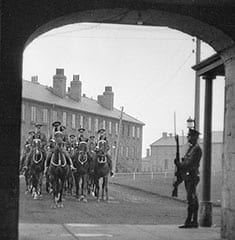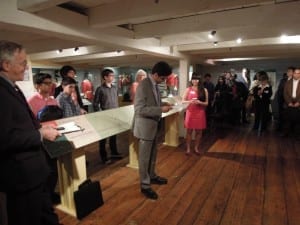Newsletter from the Friends of Fort York & Garrison Common features items of interest related to blurbs and slogans

An aerial view of Fort York looking east shows the substantial progress on the Visitor Centre that’s been made by 2013. Photo by Danny Williams. Source: October 2013 Fife & Drum newsletter published by The Friends of Fort York and Garrison Common
I have been following the newsletter from Friends of Fort York & Garrison Common for some years. I find the newsletter contents of interest, on occasions when I get around to reading it.
I also think a larger point size for the text – say, Adobe Caslon Pro 11, 11.5 or even 12 – in place of what appears to be Adobe Caslon Pro 10 – would work well, for the newsletter.
As well, slightly more space between lines is also an option.
These are just thoughts that occur to me, as I have also noted at a previous post some years ago.
A larger point size would have all manner of consequences, of course. It would mean that texts would need to be shortened in order to take into account a larger point size. The payoff would possibly be that more people would read the articles.
The power of blurbs, slogans, and taglines
The tension between cramming as much text into a given space as possible (a desire that archivists appear at times, at least from my anecdotal observation, to cherish) versus the desire that people have to just get the gist of things is a source of endless fascination for me, if not necessarily for anybody else.
I’ve discussed this topic further in previous posts regarding the function of blurbs. As texts get shorter and shorter, you enter into the territory of taglines, political slogans, and public relations. The world history of warfare, including the history of irregular warfare, is concerned with blurbs as well as the related topic of stereotyping, which serves as a powerful, often lethal, form of story management.
I do not think that there will ever be a change in the point size. I mention the matter merely because I enjoy thinking about such things.
I have also discussed Fort York in the context of postwar emergency housing associated with military barracks that are a part of the history closely or distantly (I do not know which) associated with Fort York. I have outlined this topic in a series of posts including:
Toronto’s 1950s emergency housing: An informative, comprehensive overview by Kevin Brushett (2007)
The latter series of posts has led to some people, who lived in such housing as children and adolescents, to get in touch with each other via this website, in some cases after the passage of over 60 years.
I am delighted to have the opportunity to help out with such reconnections among site visitors. Similar reconnections have been made, among other reconnections, in relation to Cartierville School in Montreal, which I attended in the 1950s. Such reconnections warm my heart. I am so pleased to have the opportunity to help out in this way.
I have recently been reading a life story, available online, which my mother arranged to have published in the early 2000s, through taking part in a writing competition focusing on Estonian life stories. 300 submissions led to 100 stories chosen for publication. The Estonian author Jaan Kross headed the selection committee.
In her life story, my mother mentions Cartierville School as an idyllic institution, with large school grounds, close to the Back River in Cartierville.As was the case with students who had attended it, fond memories of the school stayed in mind for her.
But that is an aside. I am working on a post about my father’s photo album from the 1936 Berlin Olympics. As part of my research, I have been reading my mother’s life story, which includes a passage from her own mother’s three books of memoirs. Two of my grandmother’s memoirs deal with prewar years in Estonia; the third deals with postwar years in exile.
I’ve also been reading a book published in Estonia in 2000, based on an uncle’s published prose works including excerpts from his father’s (my grandfather’s) letters up to 1955. The latter excerpts had been published in an Estonian-language Swedish newspaper, after my grandfather passed away.
My father attended the 1936 Olympics as a student observer from the University of Tartu. His photo album will best be addressed as a chapter in a book I am writing.
A blog post is not the best venue for such a story. But a post or two, related to such a chapter, will work fine – as a blurb pointing to the book chapter.
The book will be part of a five-year project, during which I will continue to cut back on blog posts at this website.
Reconnections
When I first set up this website, my interest was local history. I also have an interest in hearing what people have to say. That combination has led to many people getting in touch with each other. That feature – the concept that this website could serve as a means whereby people, now living across North America and elsewhere, are able to touch base with each other after 50 or 60 years – is one of the unexpected, and delightful things that this website has given rise to. I am very pleased that I can help out in this way.

Royal Canadian Dragoons leaving Stanley Barracks through the arch, c 1925 (courtesy City of Toronto Archives/Fonds 1266, Item 4985). The photo is from a citiesintime.ca webpage entitled: Stanley Barracks: Toronto’s Last Fort. The image appears in a previous post: Toronto’s 1950s emergency housing: An informative, comprehensive overview by Kevin Brushett (2007)
The current Fort York newsletter includes a notice calling for a new, volunteer managing editor for the publication. As a public service, I am pleased to post the text below:
New Managing Editor Sought for Fife & Drum
The search is on to find within the next six months a successor to the current managing editor of this newsletter, who has indicated a wish to step down. Currently, the managing editor’s responsibilities include the following tasks:
• Coordinating the process so all involved get real satisfaction from it.
• Originating with input from others a balanced lineup of subjects for articles having a connection with Fort York, usually three or more months in advance; negotiating and persuading qualified authors to take them on; giving guidance as to length, focus, quality, diversity of our non-expert readership, and character of the publication. F&D is a newsletter, not a refereed journal.
• Maintaining contact by e-mail and phone with authors through the development and writing process, referring them to sources they may not know about.
• Sourcing and securing 300 dpi files of illustrations in consultation with the authors, licensing their use, and paying fees as needed. These files are sent with captions and credits to the designer as they come in, not held until text is edited.
• Checking on delivery of draft texts to text editor about six weeks before quarterly publication deadlines, more urgently three weeks before.
• Selecting titles for the articles in concert with the author and the text editor.
• Undertaking with the text editor and other editorial experts, but not the author, proofreading of first, second, sometimes third drafts as the designer makes adjustments, typos are rooted out, and final tweaks are made.
• Ensuring authors receive a copy by e-mail of the issue where their pieces appear, and are thanked appropriately.
Neither the managing editor nor other staff working on the newsletter are paid for their services.
Authors are invited to contribute pro bono. Fees for the use of illustrations are paid only with great reluctance.
The Fife & Drum has been published gratis and quarterly by The Friends of Fort York continuously since May 1996.
http://www.fortyork.ca/images/newsletters/fife-and-drum-2016/fife-and-drum-july-2016.pdf
It has been curated by the present managing editor since November 2003.
If you are interested in being considered for appointment as managing editor of Fife & Drum please send by 31 August 2017, a brief resumé of your experience with a covering letter explaining why you would like to be selected.
These should go to: Mr. Don Cranston, Chairman, The Friends of Fort York,
260 Adelaide St. E., Box 183, Toronto, M5A 1N1, or by e-mail to him at fofy@sympatico.ca
[End]

Each discussion group chose a spokesperson at the beginning of the discussion. The spokesperson then spoke for a few minutes to the assembled group sharing highlights. Jaan Pill photo. Source: Citizenship Ceremony at Fort York, April 26, 2013, featured sharing of thoughts about what it means to be a Canadian
Comment
In order to read the current newsletter, I converted the PDF file into a text format, which I then copied into a Word file. In the process, all of the graphics and formatting was stripped out. I then set up the text in Time New Roman at 12 points, and set the line spacing at 1.25. I occasionally go through such a procedure, in order to read the text. Usually, I just leave it go, however.
Some previous posts, connected with the newsletter, have focused among other topics on:
I have also visited Fort York over the years, including to attend a First Nations Sunrise Ceremony, starting at the Lake Ontario shoreline, connected with the War of 1812, and to attend a Citizenship Ceremony in which I had the opportunity to participate in a discussion among individuals who were about to take part in the ceremony. That was a memorable experience:

Leave a Reply
Want to join the discussion?Feel free to contribute!